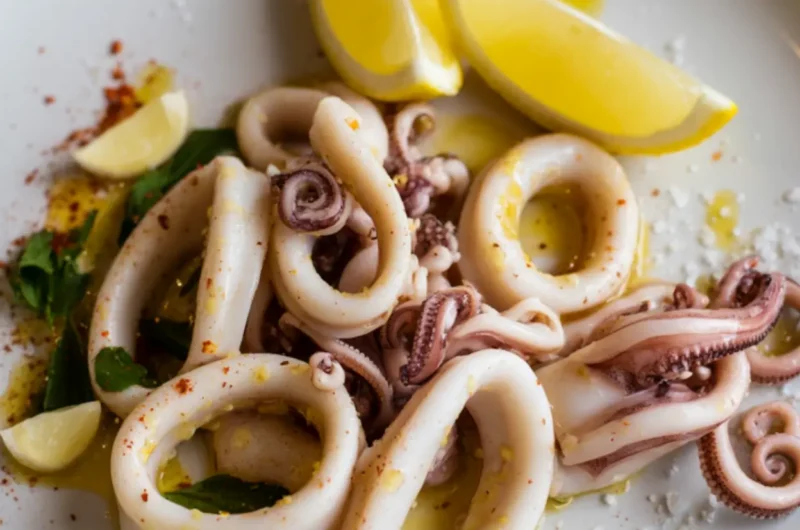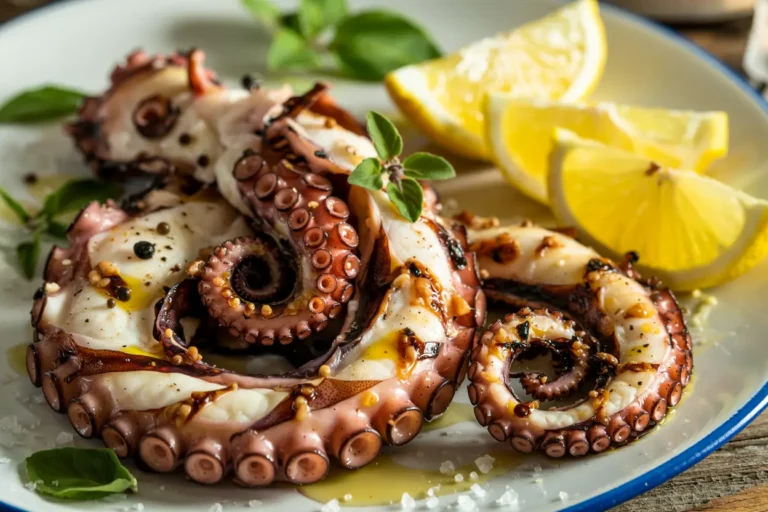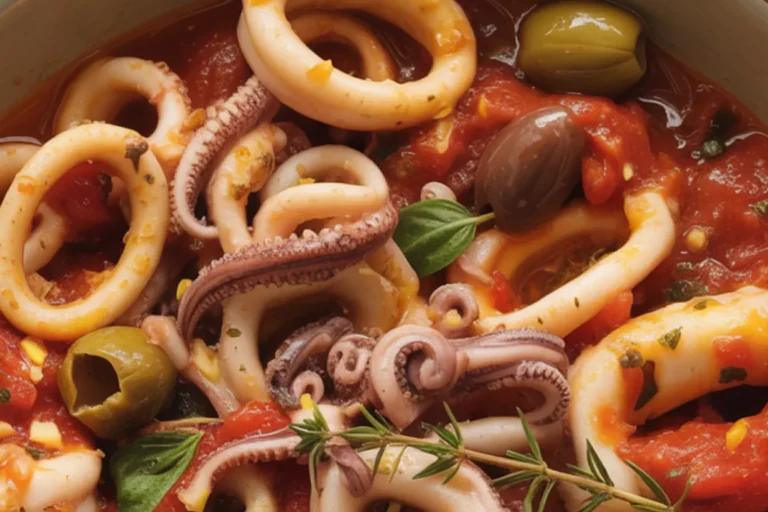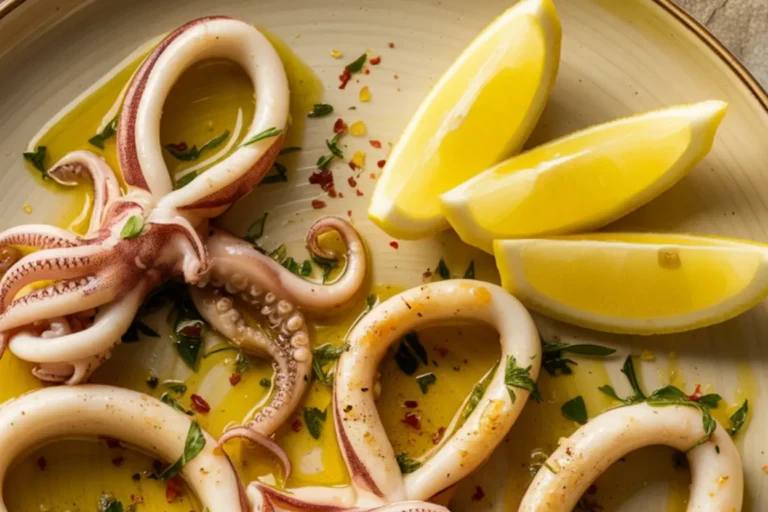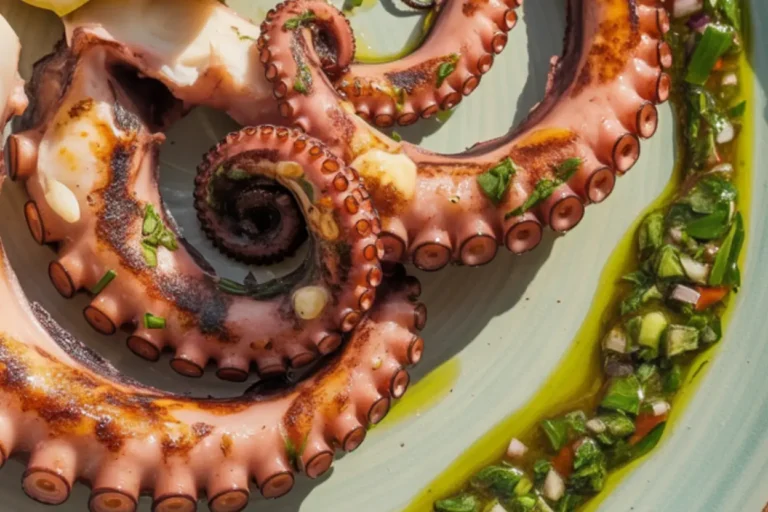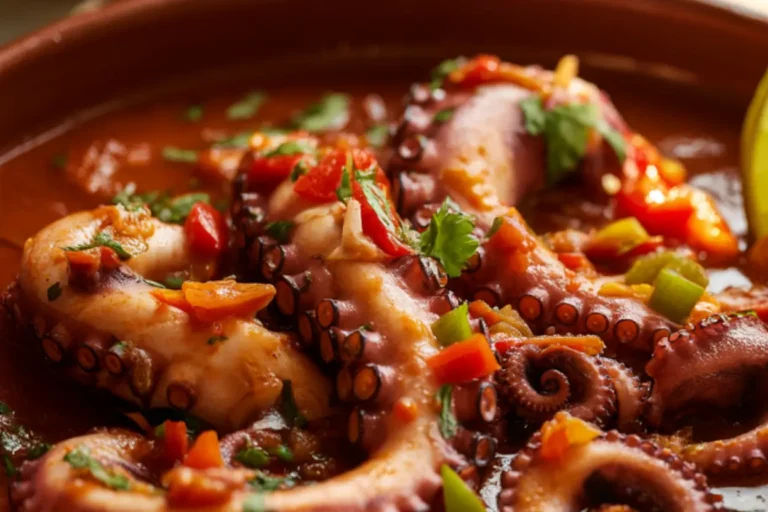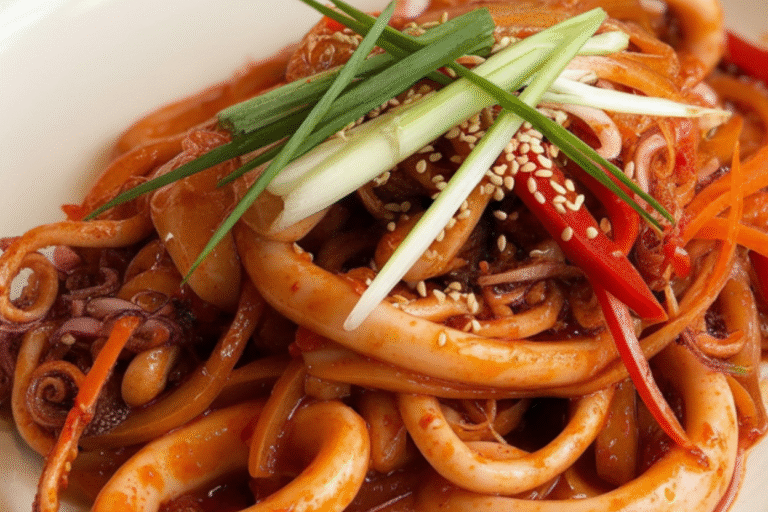Sautéed Calamari Recipe: 5 Easy Steps for Tender Results
Table of Contents
Perfectly sautéed calamari has the power to transport you to a seaside Mediterranean restaurant with just one bite. Yet, many home cooks shy away from preparing calamari, fearing the dreaded rubber-band texture that comes from improper cooking. After years of experimenting with various techniques and sharing my seafood recipes online, I’m thrilled to reveal my foolproof method for creating restaurant-quality sautéed calamari right in your kitchen.
Thank you for reading this post, don't forget to subscribe!The beauty of this dish lies in its simplicity, speed, and impressive results. Whether you’re planning a special date night dinner, entertaining guests, or simply elevating your weeknight meal rotation, this sautéed calamari recipe delivers delicate, tender results that will make you wonder why you ever ordered it at a restaurant. Let me guide you through my perfected technique that guarantees tender, flavorful calamari every single time.
How to Make Sautéed Calamari
Quick Overview
This sautéed calamari dish stands apart from typical fried calamari by focusing on the delicate sweetness of the squid enhanced with garlic, white wine, and fresh herbs. What makes this recipe particularly appealing is its remarkable simplicity paired with gourmet results. The calamari is quickly sautéed until just tender, preserving its delicate texture while infusing it with Mediterranean flavors.
One of the greatest advantages of this recipe is its speed – from start to finish, you’re looking at just 20 minutes total cooking time, including only 5-7 minutes of actual sautéing. The lightning-fast cooking time is actually the secret to achieving that perfect tenderness that many home cooks find elusive. The result is delicate, slightly sweet calamari with a flavor that’s enhanced but never overpowered by the supporting ingredients.
The dish features a light sauce that forms naturally from the calamari’s juices, wine, and butter, creating a silky coating that’s perfect for sopping up with crusty bread. It’s an elegant yet unfussy preparation that showcases the natural flavors of the seafood while adding just enough complementary elements to create a harmonious, restaurant-worthy dish.
The Ingredients I Use to Bring My Sautéed Calamari to Life
For the calamari:
- 1 pound (450g) fresh calamari (squid), cleaned and prepared (bodies cut into ½-inch rings, tentacles left whole if small or halved if large)
- 3 tablespoons extra virgin olive oil
- 4 garlic cloves, thinly sliced (not minced)
- ¼ teaspoon red pepper flakes (adjust to taste)
- ½ cup of dry white wine, like Pinot Grigio or Sauvignon Blanc
- 2 tablespoons fresh lemon juice
- 2 tablespoons of cold, unsalted butter, cut into small pieces
- 3 tablespoons fresh flat-leaf parsley, finely chopped
- 1 tablespoon fresh oregano, finely chopped (or 1 teaspoon dried)
- Salt and freshly ground black pepper to taste
- Lemon wedges for serving
Optional garnishes:
- Additional chopped fresh herbs
- Lemon zest
- Flaky sea salt for finishing
Step-by-Step Instructions
Step 1: Prepare the Calamari
- If using whole, uncleaned calamari, begin by cleaning them thoroughly. Pull the head and tentacles away from the body. Remove and discard the beak (the hard center portion where the tentacles connect), the quill (the clear plastic-like backbone inside the body), and the innards.
- Rinse the calamari bodies and tentacles under cold running water, then pat thoroughly dry with paper towels. This is crucial – excess moisture will cause the calamari to steam rather than sauté properly.
- Slice the calamari bodies into ½-inch thick rings. If the tentacles are large, cut them in half; otherwise, leave the small tentacles whole.
- Once sliced, lay the calamari pieces on paper towels and pat again to ensure they’re as dry as possible. Season lightly with salt and pepper.
Step 2: Heat the Pan and Oil
- Select a large, heavy-bottomed skillet or sauté pan – cast iron or stainless steel works best as they retain heat well and create a better sear. The pan must be large enough to accommodate all calamari pieces without overcrowding.
- Heat the pan over medium-high heat until it’s very hot but not smoking, about 2 minutes.
- Add the olive oil and allow it to heat until shimmering but not smoking, about 30 seconds. You’ll see the oil develop ripples across its surface when it’s ready.
Step 3: Sauté the Aromatics and Calamari
- Stir the sliced garlic and red pepper flakes into the hot oil. Sauté for just 30-45 seconds until fragrant and the garlic is softening but not browning. Browning the garlic will create bitter notes in the finished dish.
- Working quickly, add the calamari to the pan in a single layer. If your pan isn’t large enough, cook in two batches rather than overcrowding. Overcrowded calamari will release too much liquid and steam rather than sauté.
- Let the calamari cook undisturbed for 1 minute to develop some color, then gently stir and continue cooking for just 1-2 minutes more. The calamari should be opaque but still tender. The entire cooking time for the calamari should not exceed 2-3 minutes total – this is critical for tenderness.
Step 4: Create the Wine Sauce
- Pour in the white wine and lemon juice, using a wooden spoon to scrape up any flavorful bits from the bottom of the pan (deglazing).
- Allow the liquid to simmer for 1 minute to reduce slightly and cook off the alcohol.
- Remove the pan from the heat and immediately add the cold butter cubes. Gently swirl the pan or stir with a spoon until the butter melts and creates a silky emulsion with the wine and calamari juices.
- Once the butter has melted and incorporated, immediately stir in the chopped parsley and oregano. The residual heat will release the aromatic oils in the herbs without cooking away their fresh flavor.
Step 5: Finish and Serve
- Taste the sauce and season with salt and freshly ground black pepper to your preference.
- Transfer the sautéed calamari to a warm serving dish, making sure to scrape all of the flavorful sauce from the pan.
- Garnish with additional fresh herbs, a light sprinkle of lemon zest if desired, and a few lemon wedges on the side for individual adjustments.
- Serve immediately while hot, as calamari can toughen if allowed to sit too long.
What to Serve Sautéed Calamari With
Sautéed calamari’s delicate flavor and silky sauce pair beautifully with a variety of accompaniments. Here are some perfect partners:
Bread options:
- Crusty artisan bread or baguette slices for sopping up the delicious sauce
- Garlic bread for an extra layer of flavor
- Toasted crostini rubbed with garlic and drizzled with olive oil
Side dishes:
- Simple linguine or angel hair pasta tossed with olive oil and herbs
- Lemon-herb risotto for a more substantial meal
- Mediterranean orzo salad with cherry tomatoes, cucumber, and feta
- Roasted fingerling potatoes with rosemary
- Sautéed spinach or Swiss chard with garlic
- Greek-style roasted vegetables (bell peppers, zucchini, eggplant)
Salad pairings:
- Classic Caesar salad with homemade dressing
- Arugula salad topped with shaved Parmesan, pine nuts, and a lemon vinaigrette.
- Mediterranean tomato and cucumber salad with red onion and olives
Wine pairings:
- Crisp white wines like Pinot Grigio, Albariño, or Sauvignon Blanc
- Light-bodied, unoaked Chardonnay
- For something special, a glass of Prosecco or Cava complements the delicate flavors beautifully
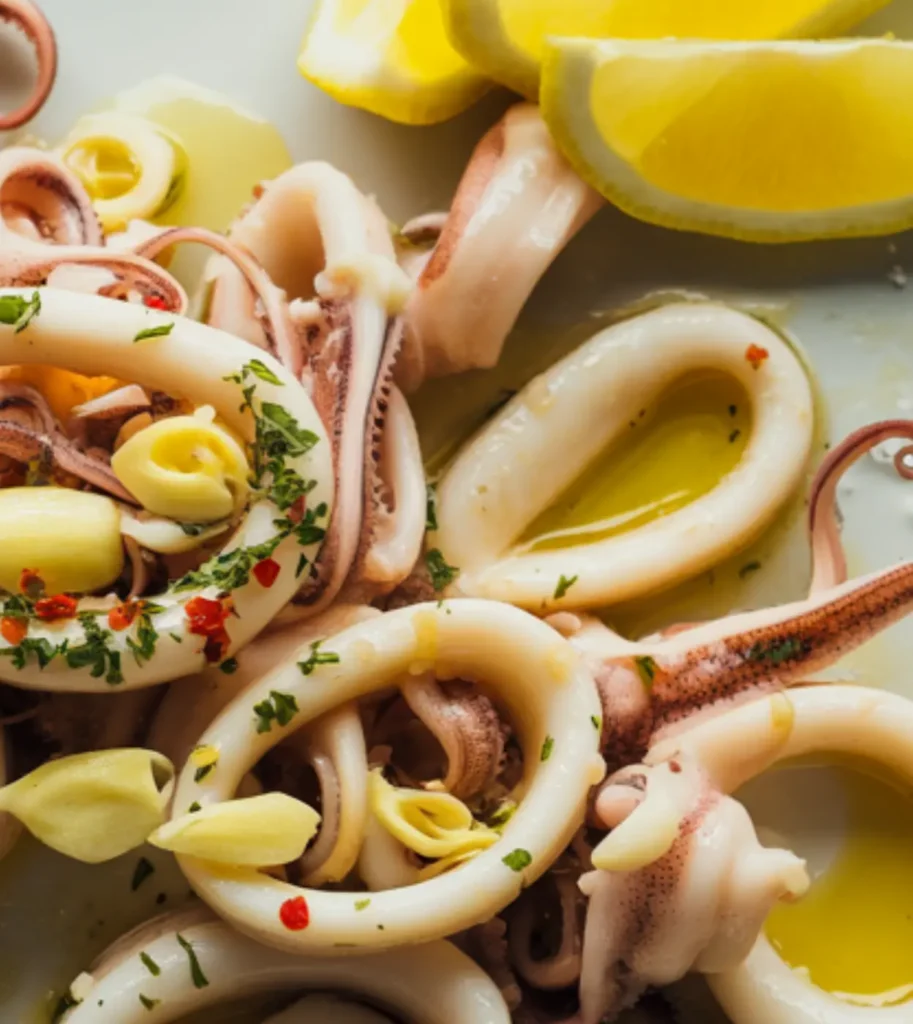
Top Tips for Perfecting Sautéed Calamari
- Master the cooking time: The number one secret to tender calamari is proper cooking time. Calamari needs either very quick cooking (2-3 minutes) or very long, slow cooking (45+ minutes) – anything in between results in a rubbery texture. For this sautéed version, we’re using the quick-cooking method, so watch your timer carefully.
- Ensure your calamari is thoroughly dried: Excess moisture is the enemy of proper sautéing. Use paper towels to thoroughly pat the calamari dry before cooking. This ensures proper caramelization rather than steaming, which impacts both texture and flavor.
- Use a very hot pan: Your pan should be thoroughly heated before adding the oil, and the oil should be shimmering before adding ingredients. This initial heat is crucial for quickly searing the calamari’s exterior while keeping the inside tender.
- Don’t overcrowd the pan: If necessary, cook in batches rather than piling all the calamari in at once. Overcrowding causes temperature drops and releases too much liquid, resulting in steamed rather than sautéed calamari.
- Consider a marinade for extra flavor: While not strictly necessary, marinating the calamari for 15-30 minutes in a mixture of olive oil, lemon juice, garlic, and herbs before cooking can add an extra depth of flavor. Just be sure to pat dry again before sautéing.
- Alternative ingredient options:
- If fresh herbs aren’t available, use 1/3 the amount of dried herbs instead
- No white wine on hand? Use chicken broth with 1 teaspoon of white wine vinegar as a substitute.
- For a dairy-free version, replace the butter with 1 additional tablespoon of good olive oil
- For a spicier version, double the red pepper flakes or add a finely minced fresh chili
- Quality matters: The freshness of the calamari significantly impacts the final dish. If fresh isn’t available, high-quality frozen calamari that’s properly thawed can work well. Just ensure it’s completely defrosted and patted very dry.
Storing and Reheating Tips
While sautéed calamari is best enjoyed immediately after cooking, sometimes you may have leftovers. Here’s how to handle them:
Short-term storage:
- Allow the calamari to cool completely before refrigerating
- Store in an airtight container for up to 2 days maximum
- Keep the sauce with the calamari to help prevent it from drying out
Freezing (not ideal but possible):
- Frozen cooked calamari will lose some of its texture, but the flavor will remain good
- Cool completely, then store in a freezer-safe container with the sauce for up to 1 month
- Leave some room for expansion in the container
- Label with the date and contents
Reheating options:
- Stovetop method (preferred): Gently reheat in a skillet over medium-low heat just until warmed through, about 1-2 minutes. Overcooking during reheating will toughen the calamari.
- Microwave method (quick but less ideal): Use 50% power in 30-second intervals, stirring between each interval, just until warmed through. Be very careful not to overheat.
Creative uses for leftovers:
- Chop leftover sautéed calamari and add to pasta with fresh cherry tomatoes and herbs for a new dish
- Add to seafood paella or risotto for added flavor
- Use as a topping for bruschetta with a dollop of aioli
- Incorporate into a seafood salad with a lemon vinaigrette
Sauce utilization:
- If you have leftover sauce but no calamari, it makes an excellent base for a quick pasta dish or can be used to flavor other seafood dishes
By following these detailed steps and tips, you’ll create sautéed calamari that rivals any restaurant version – tender, flavorful, and impressively sophisticated despite its simplicity. The quick cooking time and straightforward technique make this an accessible dish for weeknight dinners, while the elegant presentation and restaurant-quality results make it perfect for entertaining. Mastering this technique opens the door to exploring more seafood recipes with confidence, knowing you’ve conquered one of the most notoriously difficult proteins to cook properly.
Click here to follow me on Pinterest
Sautéed Calamari Recipe: 5 Easy Steps for Tender Results
Cuisine: Mediterranean / ItalianDifficulty: Easy4
servings15
minutes7
minutes220-250
kcalThis sautéed calamari dish is a bright, flavorful seafood recipe featuring tender squid quickly cooked with olive oil, garlic, red pepper flakes, white wine, and fresh herbs. Finished with lemon juice, butter, and a sprinkle of flaky sea salt, it’s light, aromatic, and perfect as a starter or main course.
Ingredients
1 pound (450g) fresh calamari (squid), cleaned and prepared (bodies cut into ½-inch rings, tentacles left whole if small or halved if large)
3 tablespoons extra virgin olive oil
4 garlic cloves, thinly sliced (not minced)
¼ teaspoon red pepper flakes (adjust to taste)
½ cup of dry white wine, like Pinot Grigio or Sauvignon Blanc
2 tablespoons fresh lemon juice
2 tablespoons of cold, unsalted butter, cut into small pieces
3 tablespoons fresh flat-leaf parsley, finely chopped
1 tablespoon fresh oregano, finely chopped (or 1 teaspoon dried)
Salt and freshly ground black pepper to taste
Lemon wedges for serving
Additional chopped fresh herbs
Lemon zest
Flaky sea salt for finishing
Instructions
- Clean and Prep the Calamari
Clean the calamari if needed by removing the quill, beak, and innards. Rinse and pat thoroughly dry. Cut bodies into ½-inch rings and halve large tentacles. Lay pieces on paper towels and season lightly with salt and pepper. - Heat the Pan and Oil
Use a large, heavy skillet (cast iron or stainless steel preferred). Heat over medium-high for 2 minutes, then add olive oil and heat until shimmering. - Cook Aromatics and Calamari
Add sliced garlic and red pepper flakes, sauté for 30–45 seconds until fragrant (don’t brown the garlic). Quickly add calamari in a single layer (cook in batches if needed). Sauté undisturbed for 1 minute, then stir and cook 1–2 minutes more until opaque and tender. - Make the Wine Sauce
Pour in white wine and lemon juice. Scrape the pan to deglaze and simmer for 1 minute. Remove from heat, add cold butter cubes, and stir to emulsify. Mix in chopped parsley and oregano. - Finish and Serve
Taste and adjust seasoning with salt and pepper. Transfer to a warm dish, drizzle with pan sauce, and garnish with extra herbs, lemon zest, and lemon wedges. Serve immediately while hot.
Notes
- Fresh calamari cooks very quickly—overcooking can lead to a rubbery texture, so keep a close eye while sautéing. The combination of white wine, lemon, garlic, and herbs brings a refreshing balance of acidity and richness. This dish is best served immediately with a crusty piece of bread or alongside a light salad. For added aroma, don’t skip the lemon zest and fresh herbs at the end!


